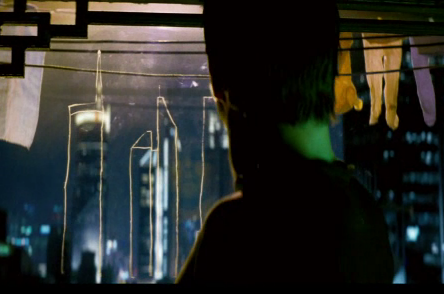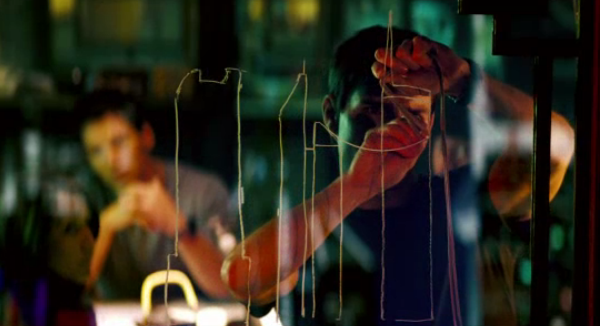Linear Algebra on a Mission Impossible
I love making math questions out of the movies. Here is a Mission Impossible III question.
Tom Cruise is cute. He plays Ethan Hunt in Mission Impossible movies. In Mission Impossible III he needs to steal the Rabbit’s Foot from a secure skyscraper in Shanghai. He arrives in Shanghai and studies the skyscraper looking out his window. He decides to break in through the roof. And the way to get to the roof is to use a rope and swing across from another, even taller, skyscraper. 1:21 minutes into the movie, Ethan Hunt calculates the length of the rope he will need by using the projection of a skyline on his window, as seen on the first picture.

Explain why the projection is not enough to calculate the length of the rope. What other data does he need for that? Ethan Hunt does request extra data. But he makes one mistake. He uses his pencil as a compass to draw the end of the rope curve, as seen on the second picture. Explain what his mistake is.

George R.:
Some thoughts. The “projection” system cannot be accurate because the window surface (drawing surface) has to be parallel to the hypothetical surface that connects the 2 buildings centers of gravity. In other words, one cannot be sure that the real objects being projected are equidistant from the window. The view angle is also important. One can’t draw at scale without knowing the horizontal distance to the object and the height difference.(Pythagoras calculation actually)
5 June 2014, 1:36 amAbout the pencil compass , I would say that the calculation is wrong because the radius of the pendulum is not enough as a parameter. A “pendulum” from the top of a taller building in order to reach the roof of the shorter would require a lot of kinetic energy/velocity (space on the first roof also) and one should calculate the rope length considerably shorter than what T.Cruz do, because after completing the circular motion ,one must let go the rope HIGHER than the top level of the destination building, and to follow a parabolic trajectory (I would say at a relative lower angle than 45 degrees).
Alicelewis:
He chooses to break in through the top. Furthermore the best approach to get to the top is to utilize a rope and swing crosswise over from an alternate, considerably taller, high rise. 1:21 minutes into the motion picture, Ethan Hunt ascertains the length of the rope he will require by utilizing the projection of a horizon on his window, as seen on the first picture.
27 July 2014, 10:18 amFree Online 6th Grade Math Practice
Dr. Tabrizi:
Several problems may be held accountable in this situation. Unless he has obtained prior measurements from his point of origin to the distance of the building, as well as the distance from the building and scales the distance utilizing the geometric pythagorean equations, he would be held at a 99%+ chance of error carrying out the jump. His “calculations” are a mere observation rather than a quantifiable estimation. There is much error in the drawing of his arc mainly because he fails to include the gravitational force acting upon him, his weight, the amount of aerodynamical-drag his suit may cause, as well as the intangibles of the rope he is using.
19 October 2014, 6:40 am